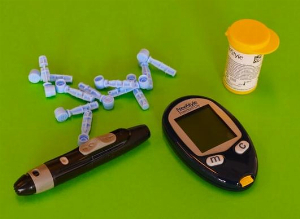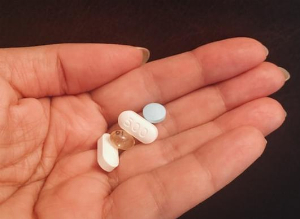What is intensive insulin therapy?
Published 13 Oct 2020 • Updated 16 Oct 2020 • By Alexandre Moreau
Intensive insulin therapy (also known as flexible insulin therapy) is a therapeutic regimen for diabetes which is based upon tight management of blood sugar levels so as to keep them closer to the levels of someone who does not have diabetes.
Indeed, intensive insulin therapy enables diabetic patients to understand their insulin needs and adapt their insulin doses to their lifestyle (food intake, physical activity, etc.). It's the treatment that adapts to the patient's lifestyle, not the other way round!
Who is this method for? How does it work? How is it taught? What are the benefits for diabetes patients?

Who is intensive insulin therapy intended for?
Intensive insulin therapy is mainly aimed at patients with type 1 diabetes who need a daily supply of insulin (a hormone secreted by the pancreas that regulates blood sugar levels). It consists of basal-bolus insulin therapy, administered via multiple injections (usually 4: at breakfast, lunch, dinner and before going to bed) using insulin pens or automatically by an insulin pump at regular intervals throughout the day.
This method may also be suitable for certain patients with type 2 diabetes (formerly known as insulin-dependent diabetes). Some are treated with injections of different types of insulin (rapid- or slow-acting), particularly after failure of first-line oral antidiabetic drugs (OADs) alone.
How does intensive insulin therapy work?
The aim of intensive insulin therapy is to mimic the natural insulin production of a healthy pancreas. The aim is to achieve blood sugar level targets which are recommended by NICE: 4 to 7 mmol/l before eating and under 8.5 to 9 mmol/l 2 hours after a meal.
Two types of insulin are used for this purpose:
- Rapid-acting insulin analogues, known as "bolus": taken at meal times (to be injected at breakfast, lunch and dinner), including insulin lispro (HUMALOG®), aspart (NOVORAPID® or FIASP®) and glulisine (APIDRA®). They do not require a delay between the injection and the meal.
- Slow-acting insulin, known as “basal” or "background insulin": in between meals, including insulin detemir (LEVEMIR®), glargine (LANTUS®, ABASAGLAR® or TOUJEO®) and degludec (TRESIBA®), or intermediate insulins with NPHinsulin (HUMULIN® and INSULATARD®, to be injected in the evening before going to bed).
Note that in the case of insulin pumps, these are small doses of rapid-acting insulin that are delivered continuously at regular intervals (basal rate) throughout the day.
How are insulin doses determined?
The goal of intensive insulin therapy is to be as autonomous as possible in order to anticipate insulin doses (for example, according to the activities one plans to do during the day) and to treat hypoglycaemia. To do this, it is necessary to know how to determine the basal and rapid-acting insulin doses.
Determining the basal insulin dose
The initial basal insulin dose is determined by a 24-hour fast test (while maintaining normal physical activity and protein and fat intake). The target is a blood sugar level between (4-7 mmol/l). It is possible to make corrections with rapid insulin or sugar:
- 1 unit lowers the blood sugar level by about 2.2 mmol/l: therefore if the fasting blood sugar level is equal to 8.3 mmol/l, 1 unit (1 IU) must be injected to be within the target (6.1 mmol/l).
- 15 g of sugar increases the blood sugar level by 2.2 mmol/l in 15 minutes: if the blood sugar level is less than 2.8 mmol/l, you should raise your sugar level back up.
It is therefore this evaluation of the rapid-acting insulin doses administered and blood sugar levels while fasting that makes it possible to estimate the dose of basal insulin required.
During treatment, the basal insulin dose is determined by measuring the fasting blood glucose level (should be between 3.9 and 6.1 mmol/l):
- if < 3.9 mmol/l: the evening dose of basal insulin should be reduced by 1 to 2 IU;
- if > 6.mmol/l: the basal insulin dose should be checked two days in a row and if this value is confirmed, the basal dose should be increased by 2 IU.
Determining the dose of rapid-acting analogue
To define the dose of rapid analogue, you need to know what you are going to eat and what physical activity(ies) you are going to engage in (anticipatory adaptation), how your blood sugar levels were after dosing in the previous days (retrospective adaptation) and how is the blood sugar level at that time (immediate adaptation). In other words, it is a question of learning to "triple adapt" doses.
When starting treatment, bolus insulin doses are determined from test meals with a 40g carbohydrate breakfast, an 80g carbohydrate lunch and a 60g carbohydrate dinner.
The dose of rapid insulin is calculated on the basis of:
- 2 IU per 10 g in the morning (so here 8 IU are required)
- 1 IU per 10 g at lunchtime (8 IU required)
- 1.5 IU per 10 g in the evening (9 IU required).
If intense and brief physical activity is planned:
- just after a meal: reduce the dose of rapid insulin from the meal before physical activity by 30 to 50%;
- long after a meal: reduce the rapid insulin dose of the next meal by 30-50%.
If you are going to be physically active for a long stretch of time (more than 2 hours): reduce the dose of rapid-acting insulin at midday and in the evening, or even the dose of basal insulin (-50% in total) and re-sugar every hour.
Where and by whom is intensive insulin therapy taught?
This method of controlling blood sugar levels is taught on an outpatient basis through training programmes at diabetes centres, hospitals, or online in full or half-day formats.
Training usually takes place in small groups and are supervised by a multidisciplinary care team of doctors, dieticians and nurses.
What are the advantages of this method?
Intensive insulin therapy allows the diabetic patient to better control his or her treatment. It reduces the occurrence of hypoglycaemia and corrects hyperglycaemia. Whereas standard "basal-bolus" insulin therapy forces the patient to eat and inject millimetric doses at fixed times, IIT adapts to the patient's lifestyle and even allows him or her to make a few deviations that are totally under control.
The quality of life of diabetic patients is thus improved, allowing them to enjoy a varied and balanced diet without any particular restrictions. The aim is to make the patient independent and to ensure that he or she can cope with all kinds of unexpected or planned situations (delayed meals, dinner in restaurants, etc.). It is a therapeutic education programme which aims to involve the patient more in the self-management of his or her treatment and illness.
Applications for smartphones such as Diabetes:M, Gluci-Chek or One Drop for Diabetes Health allow even further simplification of treatment management by patients. These applications are able to calculate the quantities of carbohydrates ingested at each meal and estimate the dose of insulin required. More and more solutions are being created to help patients become as independent as possible!
Did you like this article?
Share your thoughts and opinions with the community in the comments!
Take care!
Sources :
https://www.nice.org.uk/guidance/ng17/ifp/chapter/testing-your-own-blood-glucose-and-target-levels
https://www.insulib.com/l-insulinotherapie-fonctionnelle/article/definition
http://www.afdn.org/fileadmin/regions/alsace/100909-insulinotherapie-fonctionnelle
http://www.hegp.fr/diabeto/traitementinsulineif.html
https://www.nhs.uk/conditions/high-blood-sugar-hyperglycaemia/

 Facebook
Facebook Twitter
Twitter



